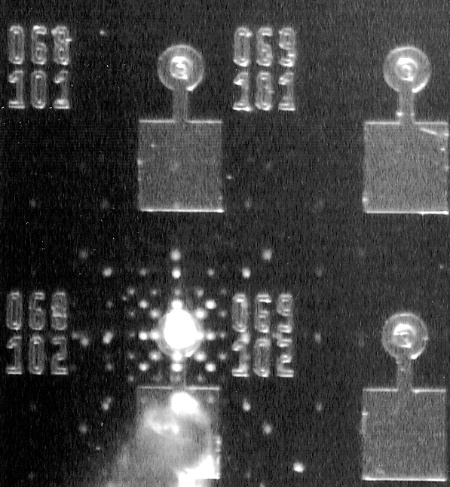Infineon Technologies Announces Breakthrough 1300nm Vertical Cavity Surface-Emitting Lasers (VCSEL) for Optical Communications Applications
Munich/Germany, April 5, 2001 - Infineon Technologies (FSE/NYSE: IFX), one of the worlds leading providers of communications integrated circuits (ICs), announced today that it has achieved a breakthrough in 1300nm Vertical Cavity Surface-Emitting Laser (VCSEL) technology. Up to now, 1300nm lasers were available only in edge-emitting laser technology. 1300nm VCSELs extend the potential range of fiber optic systems, providing inherent cost, reliability, and power advantages compared to edge-emitting laser technology.
Our Corporate Research Center developed the new 1300nm VCSEL technology, which is a key component for new datacom systems using either multimode and single-mode fiber, said Thomas Seifert, Senior Vice President and COO of Infineons Communication Group. This new technology will enable our customers to deliver first-to-market, maximum performance optical interconnect and long-haul transmission solutions.
The new 1300nm lasers can be modulated up to 10 GHz, providing the output power required for fiber optic transmission systems operating at OC-192 data rates (10 Gigabits per second). Designers can reduce their overall system complexity and system costs as well as improve system performance. Through new capabilities of the 1300nm technology, tightly spaced laser arrays can optimize port densities.
Laser device usage is regulated by government agencies to ensure eye safety. Because the human eye is 20 times less sensitive to longer wavelengths compared to 850nm wavelengths, 1300nm lasers may be operated at higher power levels. More power can be coupled into the fiber while staying within eye-safety limits, enabling transmission over a longer range.
Infineon utilized the companys long-standing expertise in molecular beam epitaxy technology and production of 850nm VCSEL components for developing the 1300nm technology. The vertically emitting laser is grown on a Gallium Arsenide (GaAs) substrate and has an active region consisting of multiple quantum wells of Indium Gallium Arsenide Nitride (InGaAsN). The mastery of this novel compound semiconductor was crucial for the new devices.
The new components emit light at a wavelength around 1300nm under continuous wave operation with a maximum output power above 1mW at room temperature. Laser action is achieved up to +80° C. The laser threshold current is about 2.0 mA at room temperature. Bit-error-free (BER<10-11) transmission was achieved up to 10 Gigabits per second.
Development work for the new technology was performed at Infineons Corporate Research Center and financially supported by the European Union and the German Ministry of Education and Research (BMBF). The Infineon 1300nm VCSEL samples will be available in 2002.
Our Corporate Research Center developed the new 1300nm VCSEL technology, which is a key component for new datacom systems using either multimode and single-mode fiber, said Thomas Seifert, Senior Vice President and COO of Infineons Communication Group. This new technology will enable our customers to deliver first-to-market, maximum performance optical interconnect and long-haul transmission solutions.
The new 1300nm lasers can be modulated up to 10 GHz, providing the output power required for fiber optic transmission systems operating at OC-192 data rates (10 Gigabits per second). Designers can reduce their overall system complexity and system costs as well as improve system performance. Through new capabilities of the 1300nm technology, tightly spaced laser arrays can optimize port densities.
Laser device usage is regulated by government agencies to ensure eye safety. Because the human eye is 20 times less sensitive to longer wavelengths compared to 850nm wavelengths, 1300nm lasers may be operated at higher power levels. More power can be coupled into the fiber while staying within eye-safety limits, enabling transmission over a longer range.
Infineon utilized the companys long-standing expertise in molecular beam epitaxy technology and production of 850nm VCSEL components for developing the 1300nm technology. The vertically emitting laser is grown on a Gallium Arsenide (GaAs) substrate and has an active region consisting of multiple quantum wells of Indium Gallium Arsenide Nitride (InGaAsN). The mastery of this novel compound semiconductor was crucial for the new devices.
The new components emit light at a wavelength around 1300nm under continuous wave operation with a maximum output power above 1mW at room temperature. Laser action is achieved up to +80° C. The laser threshold current is about 2.0 mA at room temperature. Bit-error-free (BER<10-11) transmission was achieved up to 10 Gigabits per second.
Development work for the new technology was performed at Infineons Corporate Research Center and financially supported by the European Union and the German Ministry of Education and Research (BMBF). The Infineon 1300nm VCSEL samples will be available in 2002.
About Infineon
Infineon Technologies AG, Munich, Germany, offers semiconductor and system solutions for applications in the wired and wireless communications markets, for security systems and smartcards, for the automotive and industrial sectors, as well as memory products. With a global presence, Infineon operates in the US from San Jose, CA, in the Asia-Pacific region from Singapore and in Japan from Tokyo. In the fiscal year 2000 (ending September), the company achieved sales of Euro 7.28 billion with about 29,000 employees worldwide. Infineon is listed on the DAX index of the Frankfurt Stock Exchange and on the New York Stock Exchange (ticker symbol: IFX). Further information is available at www.infineon.com.
Information Number
INFCOM200104.061e
Press Photos
-
 The figure shows several VCSELs still on wafer after processing, with one of them under operation. The contact structures, and in the center of their circular part, the active part of the lasers with a diameter of about 5 µm can be seen.Press Picture
The figure shows several VCSELs still on wafer after processing, with one of them under operation. The contact structures, and in the center of their circular part, the active part of the lasers with a diameter of about 5 µm can be seen.Press PictureJPG | 175 kb | 597 x 646 px
